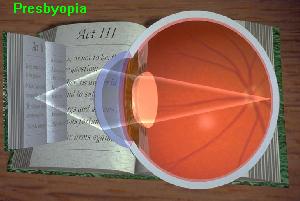The Far Sighted Eye
Presbyopia affects 100% of
the population by age 50. Currently, bifocals are the only
highly successful way to treat presbyopia.
Presbyopic individuals with
normal vision need reading glasses while nearsighted and
farsighted patients need bifocals for clear viewing at both
distance and near. Spectacle Correction: Bifocal lenses allow the user to view distance objects through the top portion of their glasses, and near objects with magnifiers added to the bottom portion of their glasses. Recently, these lenses can be blended together to produce a "progressive add" or "no line" bifocal. Special Refractive Surgery Considerations: It is important that you understand that refractive surgery DOES NOT PREVENT the age-related loss of the eye's ability to vary its focusing power. If you are over 40 and have both your eyes fully corrected for distance vision, you will need reading glasses for near work. As an alternative to reading glasses for near work, you may elect to leave one eye slightly nearsighted; an outcome called monovision.
|
